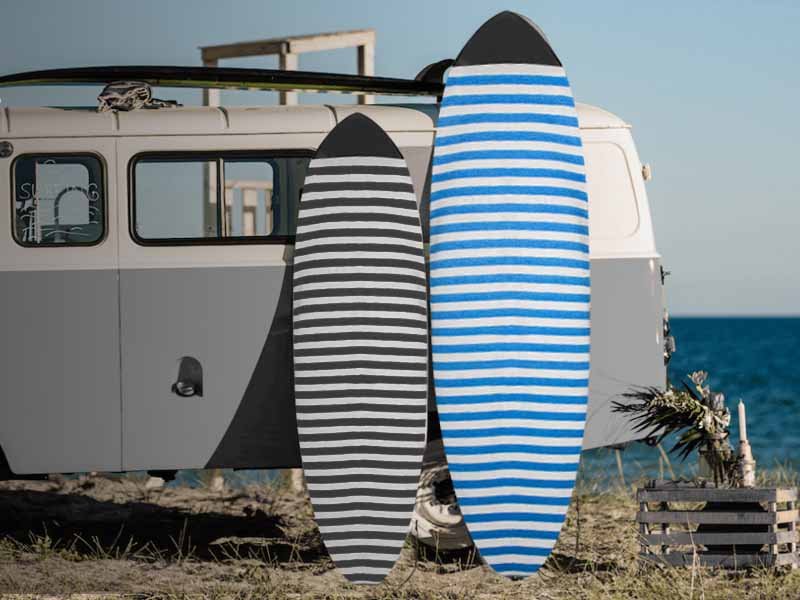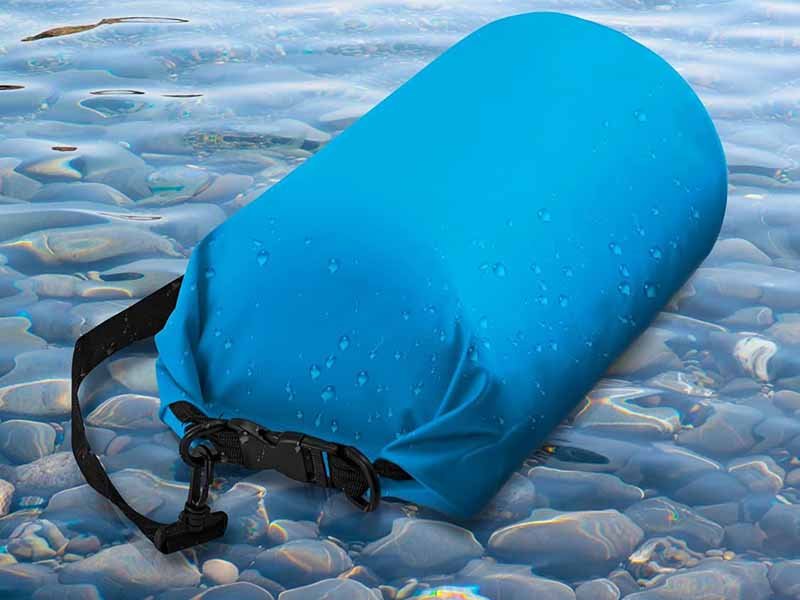Imagine stepping onto a job site, your tools neatly organized and ready to go, each one visible at a glance. No more digging through a cluttered toolbox or losing a favorite screwdriver in a heap of wrenches. A roll-up tool bag makes this scenario possible, combining portability, organization, and rugged durability. But what exactly is a roll-up tool bag, and why are tradespeople from electricians to carpenters raving about them?
A roll-up tool bag is a flexible, often cylindrical or rectangular pouch with multiple interior pockets or loops that securely hold tools. After arranging tools inside, the bag folds or rolls up and fastens with straps or buckles for compact storage. Crafted from heavy-duty fabrics like canvas, nylon, or leather, these bags keep tools organized, protected, and easily accessible, making them perfect for professionals who need to transport and identify their tools quickly on the go.
What Is a Roll-Up Tool Bag and How Does It Work?
A roll-up tool bag is essentially a portable tool organizer made from durable materials. It consists of a flat panel with an array of pockets, pouches, and loops designed to hold tools of various sizes—screwdrivers, pliers, wrenches, chisels, and more. After placing each tool in its designated slot, you fold or roll the bag so that tools sit snugly inside. Finally, buckles, straps, or Velcro tabs secure the roll, preventing tools from slipping out during transport. This design keeps everything in place, makes each tool visible at once, and allows quick access without rummaging.
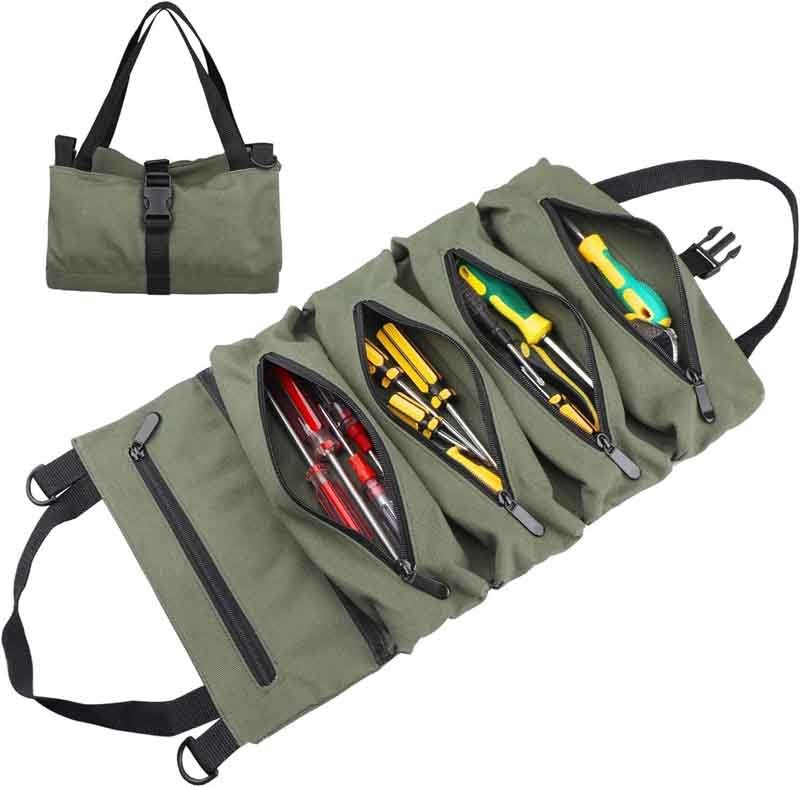
Basic Structure and Components
- Flat Panel with Tool Pockets: The interior side features multiple pockets—some sized for hand tools like hammers (5–6 inches deep), others for screwdrivers (shallow, 4–5 inches). Specialty loops hold items like pliers or utility knives.
- Material Backing & Reinforcement: A sturdy backing—often double-stitched canvas or ballistic nylon—prevents tools from puncturing through. Reinforced edges and seams ensure longevity, even under heavy use.
- Closure Mechanisms: Most bags use heavy-duty buckles made from quick-release plastic or metal. Some models employ Velcro straps for quicker, though slightly less secure, closure.
- Carrying Options: Many roll-ups include a fold-over flap that becomes a handle for easy carry. Others integrate detachable shoulder straps or D-rings for hooking onto larger toolboxes or belts.
Folding vs. Rolling Techniques
- Folding Method: Fold the bag in halves or thirds, depending on length, then secure straps horizontally around the folded section. Easier to grip but slightly bulkier.
- Rolling Method: Starting from one end, roll tightly until you reach the other edge. Straps wrap around the circumference to create a compact cylinder. Optimal for minimizing space in tool chests or backpacks.
- Hybrid Styles: Some designs combine folding at the bottom and rolling at the top—balancing compactness and ease of unrolling.
Tool Placement and Visibility
- Categorizing by Size: Place smaller tools (nail sets, hex keys) in top rows; larger ones (hammers, large pliers) in bottom pockets. This prevents heavier tools from crushing lighter ones.
- Color-Coded Pockets & Labels: Advanced bags feature color-coded seams or labels on each pocket to denote tool type. For example, red pockets for wrenches, yellow for pliers—reducing time spent searching.
- Accessibility Sequence: Consider arranging tools from most-used to least-used, left to right. Electricians might keep wire strippers and wire nuts closest to the opening, with cable cutters further down.
Size Variations and Capacity
| Bag Size Category | Approximate Dimensions (Unrolled) | Pocket Count | Ideal For |
|---|---|---|---|
| Compact (Small) | 12 x 18 inches | 8–12 pockets | Basic kits, DIYers |
| Medium | 18 x 24 inches | 16–24 pockets | Electricians, plumbers, mechanics |
| Large | 24 x 36 inches | 30–40 pockets | Carpenters, heavy trades |
| Extra-Large (Modular) | 36 x 48 inches | 40+ pockets | Industrial, multi-trade use |
- Compact Models (12 x 18 inches): Fit into backpacks or small toolboxes. Best for technicians carrying a core set of essential hand tools.
- Medium Models (18 x 24 inches): Accommodate a broader range—screwdrivers, wrenches, pliers, chisels. Ideal for tradespeople moving between sites.
- Large Models (24 x 36 inches): Meant for heavy toolsets in construction or automotive repair. Often too bulky to backpack but roll neatly in large tool chests.
- Modular Extra-Large (36 x 48 inches): Some brands offer modular attachments—detachable pouches for specialized tasks (electrical, HVAC, carpentry). Customize the layout to match multi-disciplinary roles.
Use Case Scenarios
- Electricians: Need quick access to insulated pliers, voltage testers, and cable strippers. Roll-up design prevents accidental short circuits by keeping metal tools separated.
- Plumbers: Carry pipe wrenches, basin wrenches, and plumber’s tape. Waterproof liners inside pockets protect against moisture from pipe leaks.
- Mechanics: Use folded pouch compartments for socket sets, ratchets, and wrenches. Rolling prevents sockets from rattling loose.
- DIY Enthusiasts: Store minimal essential tools—screwdrivers, tape measure, utility knives—in a compact 12 x 18 roll-up that fits under a workbench or in a car trunk.
Which Types of Roll-Up Tool Bags Are Available?
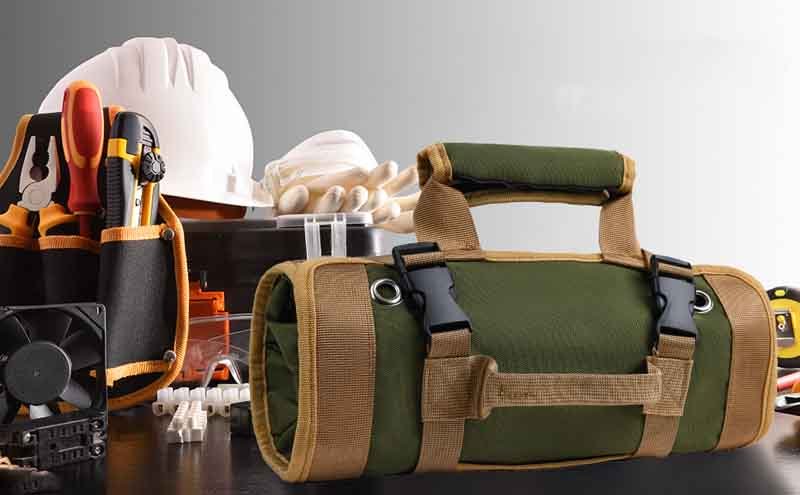
Roll-up tool bags come in various styles: canvas or nylon roll-ups with open-top pouches, leather tool rolls for upscale aesthetics, modular systems with detachable pouches, and zipper-closure bags for added security. Specialty versions include insulated rolls for grease-resistant tools and waterproof bags for outdoor jobs. Trade-specific designs target electricians, carpenters, and mechanics with role-tailored pocket configurations and materials.
Material-Based Categories
Canvas Roll-Ups:
- Made from heavy-duty cotton canvas (8–12 oz fabric weight). Durable, breathable, and moderately water-resistant when treated.
- Pros: Affordable ($15–$30 for small-to-medium sizes), easy to clean, lightweight.
- Cons: Limited abrasion resistance compared to synthetic fibers; fades over time.
Nylon and Polyester Roll-Ups:
- Uses 600–1680 denier ballistic nylon or polyester blends. Highly tear-resistant, water-repellent when coated (PU or TPU finish).
- Pros: High durability, easy wipe-down cleaning, available in vibrant colors.
- Cons: Can be stiffer, slightly heavier than canvas; prone to zipper jams if cheaply made.
Leather Tool Rolls:
- Full-grain or top-grain leather, often 1.2–1.5 mm thick. Offers a premium look, excellent longevity, natural water resistance when conditioned.
- Pros: Timeless aesthetic, molds to tool shapes over time, develops patina.
- Cons: High cost ($70–$200+), heavier, requires upkeep (conditioning, avoiding prolonged water exposure).
Hybrid Material Designs:
- Combines leather trim with nylon or canvas main body. Leather used on high-abrasion zones (strap attachment points, tool pockets), nylon for flexibility.
- Pros: Balanced weight, cost, and durability.
- Cons: More complex manufacturing, costlier than single-material bags.
Closure Styles
Open-Top with Buckle Straps:
- Most common. Tool pockets are open at top; roll and clip buckles to secure.
- Pros: Quick access; adjustable tightness based on tool load.
- Cons: Less secure in dusty environments; interior tools can spill if unrolled carelessly.
Zippered Closure:
- A full-length or partial zipper encloses the roll. Often paired with additional buckle straps.
- Pros: Prevents dust ingress, secures smaller tools.
- Cons: Potential zipper failure over time; slower tool retrieval.
Velcro Straps and Flap Covers:
- Velcro straps wrap around folded bag; a flap covers top row of tools.
- Pros: Fast open and close; quieter than snaps.
- Cons: Velcro can lose grip over months, collects debris.
Pocket and Loop Configurations
| Bag Style | Pocket Type | Typical Pocket Count | Specialty Features |
|---|---|---|---|
| Electrician’s Roll-Up | Insulated Pliers Pockets, PVC-lined | 8–12 | Electrical tape loop, integrated wire cutter sleeve |
| Carpenter’s Tool Roll | Hammer Loop, Chisel Slots, Nail Pockets | 10–14 | Carpenter pencil holder, measuring tape clip |
| Mechanic’s Socket Roll | Elastic Socket Loops, Wrench Pockets | 16–20 | Magnetic-top strip for bits, oil-resistant lining |
| Painter’s Brush Roll | Brush Sleeves, Roller Cover | 6–8 | Paint can opening, splash guard |
| Barber’s/Stylist Roll | Shear Pockets, Comb Slots | 12–16 | Sanitary lining, outer zipper for razors |
- Electrician’s Rolls: Insulated nylon pockets prevent accidental electrical conductivity. Include small ESD-resistant pouches for sensitive electronics.
- Carpenter’s Rolls: Reinforced bottom edge (cordura or leather) for carrying heavy chisels and hammers. Nail pockets sized for up to #16 finish nails.
- Mechanic’s Rolls: Heavier gauge canvas with oil-resistant lining. Elastic loops sized for metric and SAE sockets; separate compartments for ratchets.
- Multi-Trade Modular Systems: Interlocking pouches attach via MOLLE webbing; customize layout based on job—electrical, plumbing, general maintenance.
Specialty Variations
Insulated or Oil-Resistant Tool Rolls:
- Lined with neoprene or PVC for liquids and grease.
- Popular with HVAC techs and mechanics working in oily environments.
Waterproof or Weatherproof Rolls:
- Fully sealed seams and welded zippers; made from waterproof fabrics like tarpaulin or coated ripstop nylon.
- Ideal for outdoor electricians, marine technicians, and construction workers in rainy climates.
Compact Travel Rolls:
- Designed for quick deployment in pencil bag format; 8–10 pockets for small precision tools (watch repair, electronics repair).
- Lightweight canvas or ripstop nylon; can fit in backpack compartments.
Size Variations
| Size Category | Unrolled Dimensions (inches) | Rolled Dimensions (inches) | Best For |
|---|---|---|---|
| Micro (Small) | 8 x 12 | 8 x 3 | Electronics, small hand tools |
| Standard | 12 x 18 | 12 x 4 | Residential electricians, carpenters |
| Large | 18 x 24 | 18 x 5 | Professional mechanics, large kit users |
| Extra-Large | 24 x 36 | 24 x 6 | Industrial technicians, contractors |
Micro Rolls (8 x 12 inches):
- Perfect for carrying a small set of precision screwdrivers, hex keys, utility knives.
- Often used by electronics hobbyists or watch repair professionals.
Standard Rolls (12 x 18 inches):
- Accommodates up to 12–18 tools, including medium-size pliers, screwdrivers, small hammers.
- Versatile for most trade professionals seeking both portability and capacity.
Large Rolls (18 x 24 inches):
- Fits up to 24–30 tools; includes deep hammer loops, wide plier slots, and multiple small accessory pockets.
- Common among automotive and industrial technicians.
Extra-Large Rolls (24 x 36 inches):
- Essentially a complete mobile toolkit; can stow even power tool accessories.
- Ideal for large-scale construction sites or multi-disciplinary maintenance crews.
Comparing Styles & Use Cases
Electrician’s Choice vs. Mechanic’s Choice:
- Electrician’s rolls prioritize insulated pockets and tool-specific loops (wire strippers, voltage testers).
- Mechanic’s rolls need oil-resistant linings, magnetic bit strips, and socket loops up to ½-inch drive.
Cost vs. Durability Trade-Offs:
- Canvas models ($15–$30) vs. ballistic nylon ($30–$60) vs. leather ($70–$200).
- Choose based on environment: leather for dry, controlled conditions; nylon for outdoor, rough usage.
How Are Roll-Up Tool Bags Constructed and What Materials Are Commonly Used?
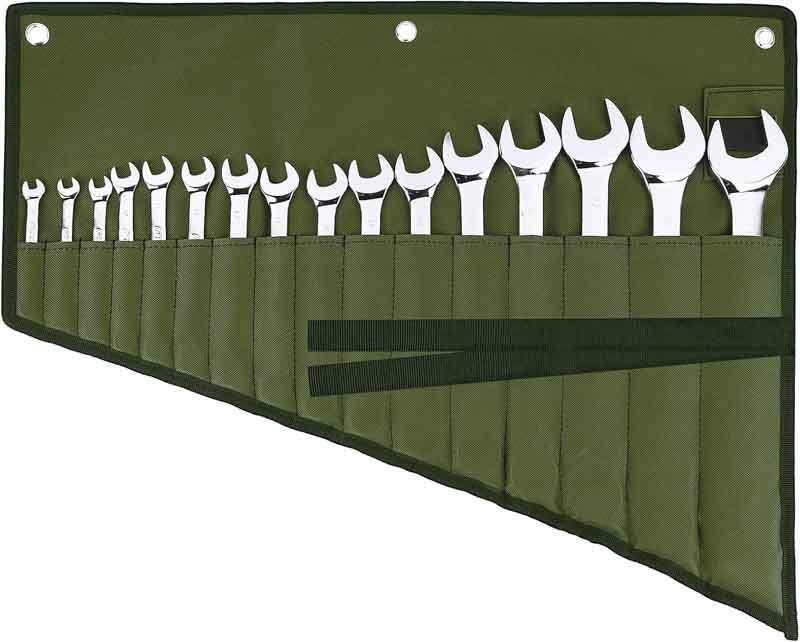
Roll-up tool bags are typically constructed from heavy-duty fabrics—canvas (8–12 oz), ballistic nylon (600–1680 denier), or leather (1.2–1.5 mm)—with reinforced seams and abrasion-resistant backing. Tool pockets use double-layer stitching or box-stitch reinforcements. Hardware like buckles, D-rings, and zippers employ corrosion-resistant metals. High-end models feature PU-coated fabrics for water resistance and heat-sealed seams to prevent moisture ingress.
Primary Fabric Choices
Cotton Canvas (8–12 oz):
- Weight: 8–12 ounces per square yard; breathable and affordable.
- Pros: Easily dyed, soft hand feel, repairs and patches are straightforward.
- Cons: Moderate abrasion resistance (1,500–2,000 Martindale cycles), absorbs moisture unless treated.
Ballistic Nylon (600–1680 Denier):
- Weight: 11–18 oz per square yard; originally made for flak jackets.
- Pros: Extremely durable (3,000–5,000 Martindale cycles), water-repellent when coated, resists tears.
- Cons: Heavier and less flexible than canvas, limited breathability.
Polyester Blends (Ripstop or High-Density):
- Often blended with TPU laminate for waterproofing.
- Pros: Lighter than nylon, cheaper, customizable from 300–700 denier.
- Cons: Lower abrasion resistance (1,000–1,500 Martindale cycles), melts under high heat.
Leather (Full-Grain or Top-Grain, 1.2–1.5 mm):
- Typically used for edges, pockets, straps, or entire tool rolls in premium lines.
- Pros: Natural water resistance, ages well, high tensile strength (30–45 MPa).
- Cons: Heavy, expensive ($8–$12 per sq ft), requires conditioning.
Reinforced Backing and Liners
- PVC-Coated Polyester Backing:
- Heat-laminated to main fabric; adds rigidity and water barrier.
- Cost: $1–$2 per linear yard.
- Neoprene or Foam Inserts:
- Provide tool cushioning and shape retention.
- Used in pockets for delicate tools like laser levels or electronics testers.
- Adds $2–$4 per bag in material costs.
Pocket and Loop Reinforcements
Double-Stitching and Box-Stitch:
- High-stress areas—pocket mouths, hammer loops, belt loops—use box-stitch patterns to distribute load.
- Labor: 0.2–0.5 hours per bag, incrementing manufacturing cost by $3–$7.
Bar Tack Reinforcements:
- Zigzag stitch reinforcement at pocket corners and strap anchors to prevent tearing; each bar tack costs $0.10–$0.20 in labor.
Rivets and Grommets:
- Sometimes used at stress points for added strength; brewing hardware costs of $0.10–$0.25 per piece.
- Grommets (metal eyelets) allow drainage and hanging loops; each grommet costs $0.05–$0.10.
Hardware and Fasteners
| Hardware Component | Material | Cost (USD per unit) | Function |
|---|---|---|---|
| Quick-Release Buckles | Acetal Plastic, Metal | $0.50–$1.50 | Secure roll, easy one-handed operation |
| Snap Buttons | Stainless Steel or Brass | $0.20–$0.40 | Keep flaps closed, align fold lines |
| D-Rings | Zinc Alloy, Stainless Steel | $0.30–$0.60 | Attach shoulder straps, hang bag on hooks |
| Zippers | YKK Coil or Aquaguard | $2–$4 | Seal tool compartments, provide dust/water resistance |
| Webbing Straps | 1–2 inches wide Nylon | $0.50–$1.00 per ft | Strap tool roll, reinforce handles |
Stitching Thread and Hardware
Thread Options:
- Polyester-waxed thread (0.6–0.8 mm) with breaking strength 12–15 kg; resists UV and mildew.
- Nylon thread (Bonded #69) for heavy-duty applications, offers higher abrasion resistance.
Seam Types:
- Lock Stitch: Standard for most seams; requires single needle sewing machine.
- Chain Stitch: Provides stretch, often used for curved seams.
- Saddle Stitch (Hand Stitch): Found in leather-only models; extremely durable, doesn’t unravel if cut.
Manufacturing Process Overview
| Step | Explanation |
|---|---|
| Pattern Cutting | CNC or hand-cut patterns ensure precision consistency |
| Pocket & Liner Attachment | Sew pocket panels to backing; stitch in loops and labels first |
| Main Body Assembly | Align and sew primary side seams, install zipper tracks |
| Hardware Installation | Attach buckles, D-rings, snaps using industrial-grade rivet tools |
| Edge Binding & Finishing | Fold and sew binding tape or leather edging for a clean finish |
| Quality Inspection | Check for seam integrity, zipper function, pocket alignment |
| Final Packing | Collapse and roll, then secure with straps or place in packaging |
Quality Assurance and Testing
- Load Testing: Hang 50 lb weight on fully loaded roll-up for 24 hours; inspect for seam separation.
- Abrasion Resistance Test: Subject sample to 5,000 Martindale cycles; check for fraying or holes.
- Seam Strength: Pull test at 10 kg per pocket; verify no pop or tear under repeated opening.
- Water Resistance Testing: Spray 10,000 mm water column for 2 hours; no water penetration in seams or fabric.
Sustainability Considerations
Material Certifications:
- Look for fabrics with OEKO-TEX or Bluesign certifications ensuring low chemical impact.
- Leather should be Leather Working Group (LWG) certified for responsible tanning.
Recycled Fabrics and PU Coatings:
- Some manufacturers use 100% recycled PET fabrics (500 denier) laminated with eco-friendly PU.
- Recycled nylon (e.g., ECONYL) reduces landfill waste but may cost 10–15% more per yard.
End-of-Life Recycling:
- Modular bag designs allow replacing individual pockets or straps rather than entire bag.
- Recycling programs by manufacturers collect old tool rolls for material recovery.
What Are the Key Benefits of Using a Roll-Up Tool Bag?
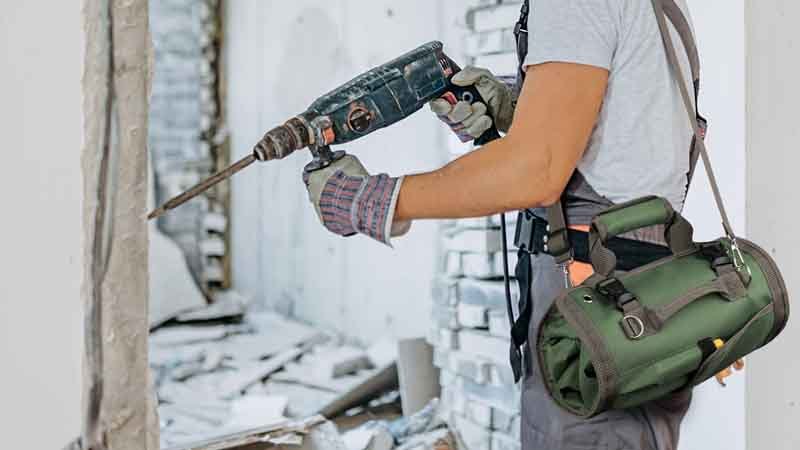
Roll-up tool bags offer unmatched portability, organization, and space efficiency. By displaying tools in plain sight, they eliminate time wasted searching. Durable materials protect tools from damage, while easy rolling and compact storage reduce workspace clutter. Versatile designs cater to various trades, enabling quick loadout, lightweight transport, and seamless integration into larger tool systems.
Superior Organization and Accessibility
Visual Inventory:
- Tools are visible at once; no rummaging through multiple drawers or compartments. Tradespeople can immediately spot missing or misplaced items.
Customizable Layout:
- Adjustable pockets and loops adapt to evolving tool sets—add or remove items without buying a new bag.
Quick Deployment:
- Unroll within seconds to reveal the entire kit. Time saved (up to 5 minutes per job) adds up over a workweek.
Portability and Space Efficiency
| Feature | Roll-Up Tool Bag | Traditional Tool Box |
|---|---|---|
| Storage Footprint | 18 x 24 x 3 inches (rolled) | 24 x 18 x 24 inches |
| Transportation | Easily fits in small vans, backpacks | Requires sizable trunk or truck bed |
| Weight (Empty) | 1.5–3 lb | 15–25 lb |
| Capacity (Tools) | 12–30 tools | 50+ tools |
Slim Profile:
- Rolled dimensions (18 x 24 x 3 in) tuck into tool drawers, under benches, or behind seats. Perfect for small service vans.
Lightweight Options:
- Select nylon or canvas models that weigh under 2 lb empty, reducing strain when climbing ladders or moving between sites.
Multiple Carrying Styles:
- Handles, D-rings for hooking onto belts, or shoulder straps provide hands-free transport.
Durability and Tool Protection
High-Strength Fabrics:
- Ballistic nylon resists punctures from sharp tools like chisels or screwdrivers.
Reinforced Seams and Bar Tacks:
- Strategic double-stitching at high-stress areas (pocket edges, strap anchor points) prevents tearing under heavy tool weight.
Protective Liners and Drainage:
- PVC or neoprene liners prevent oil, grease, and moisture from seeping into other tools or surfaces.
- Grommeted drainage holes prevent water from pooling, reducing corrosion risk.
Cost-Effectiveness and Scalability
Lower Initial Investment:
- Basic canvas rolls start at $15, providing immediate value compared to $50–$100 for small hard-sided toolboxes.
Expandable Capacity:
- Add modular pockets or accessory pouches to meet evolving tool needs instead of purchasing a new kit—saves up to 30% on replacement costs.
Reduced Toolkit Replacement Frequency:
- Better visibility and organization lower risk of tool damage or loss—estimate 10–15% fewer tool replacements annually.
Versatility Across Trades
Electrical Work:
- Insulated pocket linings and PVC walls safeguard against shorts. Loops sized for insulated pliers, voltage testers, wire strippers.
- Carpentry and Woodworking:
- Deep hammer loops and chisel sleeves prevent sharp edges from tearing fabric. Top flap covers protect chisels during transport.
Automotive and Mechanical Repairs:
- Oil-resistant liners, magnetic bit holders for steel sockets, and elastic loops for ratchets. Fits into crowded engine bays without toppling.
DIY Home Maintenance:
- Lighter duty models for homeowners performing occasional repairs—affordable, compact, easy to stow in a closet or garage.
Safety and Ergonomics
Reduced Trip Hazards:
- Tools stay off floors, minimizing workplace accidents from stepping on dropped items.
Balanced Weight Distribution:
- When worn on a belt or slung over the shoulder, load centers close to the body reduce back strain.
Improved Workflow:
- Less bending and crouching to retrieve tools—saves an average of 5–10 minutes per hour of work, reducing fatigue.
Environmental and Organizational Impact
Reduced Waste:
- Modular design reduces need to discard entire kits when only specific pockets fail.
Inventory Tracking:
- Workers can visually confirm tool counts before leaving a site, reducing loss by an estimated 15%.
Promotes Lean Worksites:
- Organized tool rolls encourage tidy work areas, contributing to overall jobsite efficiency and professionalism.
How Do Professionals Across Trades Use Roll-Up Tool Bags?
Electricians, plumbers, carpenters, mechanics, HVAC techs, and even photographers use roll-up tool bags tailored to their specific needs. Electricians rely on insulated pockets for pliers and testers; plumbers store pipe wrenches and basin tools in robust loops; carpenters carry chisels and carving gouges with protective sleeves; and mechanics benefit from magnetic bit holders. Customizable pocket layouts ensure each trade’s unique toolset is always accessible.
Electricians
Insulated Pockets & Protective Liners:
- Electrically insulated nylon or PVC-lined pockets prevent accidental shocks; adhere to CSA or IEC safety standards.
Common Tool Layout:
| Tool Type | Pocket/Loop Size | Notes |
|---|---|---|
| Insulated Pliers | 6-inch pocket | Fleece-lined to protect insulation |
| Screwdriver Set | 4–5-inch shallow pockets | Color-coded for Phillips/slotted distinction |
| Voltage Tester | 2-inch narrow pocket | Keeps glass tip protected |
| Wire Strippers | 5-inch deep pocket | Bottom of pocket to catch scraps |
Plumbers
Heavy-Duty Canvas with Oil-Resistant Lining:
- PVC-coated pockets handle greasy fittings.
Tool Organization:
| Tool Type | Pouch/Loop Size | Notes |
|---|---|---|
| Adjustable Wrench | 10-inch pocket | Deep, heavy-duty reinforced stitching |
| Basin Wrench | 12-inch horizontal loop | Secured horizontally to prevent swing |
| Pipe Cutter | 5-inch pocket | Snug fit to keep blade protected |
| Plumber’s Tape & Brushes | 3-inch enclosed pouch | Keeps small items from unraveling |
Carpenters and Woodworkers
Leather and Canvas Hybrids:
- Leather bottom reinforcement prevents chisel edges from slicing through.
Sample Layout:
| Tool Type | Pocket/Slot Size | Notes |
|---|---|---|
| Chisels | 1–2-inch wide slots | Slotted vertically, secure grip |
| Hammer | Looped by handle | Top flap holds head to protect interior |
| Measuring Tape | Spring clip holder | Allows one-handed retrieval |
| Carpenter’s Pencil | 0.25-inch narrow slots | Easy access, no rolling away |
Mechanics and Automotive Technicians
Oil-Resistant, Sealed Pockets:
- Chainsaw-proof pocket flaps protect ratchets, sockets, and wrenches from oil and grease.
Tool Layout Example:
| Tool Type | Pocket/Loop Size | Notes |
|---|---|---|
| Deep & Shallow Sockets | Elastic loops (1–2 in) | Magnetic strip secures bits |
| Ratchets | 6-inch pocket | Padded to protect finish |
| Screwdriver Bits | Magnetic bit holder | Prevents bits from rattling |
| Pliers & Wire Cutters | Reinforced nylon loops | High-stress stitched area |
HVAC Technicians
Insulated and Weatherproof Materials:
- Heavy-duty nylon with water-resistant zippers; protects thermometers, gauges, and insulated tools from humid or cold conditions.
Typical Configuration:
| Tool Type | Pocket/Loop Size | Notes |
|---|---|---|
| Refrigerant Gauges | Fleece-lined pocket | Prevents glass breakage |
| Thermometer | 5-inch pocket | Ventilated for quick readings |
| Insulated Torque Wrench | 8-inch pocket | Keeps calibration intact |
| Utility Knife | Snap-in holster | Blade locked for safety |
DIY Home Users and Hobbyists
Lightweight Canvas or Polyester Rolls:
- Basic 12 x 18-inch models with 8–12 pockets hold screwdrivers, pliers, tape measure, and utility knives.
Example Layout:
| Tool Type | Pocket/Loop Size | Notes |
|---|---|---|
| Screwdrivers | 4-inch pockets | Color-coded handles for quick ID |
| Utility Knife | 1.5-inch slot | Retractable blade safety |
| Tape Measure | Clip-on holster | One-handed use, quick grab |
| Small Hammer | Loop with retention strap | Prevents bouncing out |
Pros and Cons by Trade
| Trade | Advantages | Potential Drawbacks |
|---|---|---|
| Electricians | Easy access, insulated pockets | Canvas models may wear prematurely in high-voltage environments |
| Carpenters | Durable leather bottom, chisel protection | Leather adds weight; higher cost |
| Mechanics | Oil-resistant lining, magnetic bit holders | Bulkier when fully loaded; heavier to carry |
| HVAC Technicians | Weatherproof materials, insulated gauges | Larger, more specialized rolls more expensive |
| DIY/Home Users | Affordable, perfectly sized for small toolsets | Limited capacity; not suited for heavy industrial tools |
How Do You Choose the Right Roll-Up Tool Bag for Your Needs?
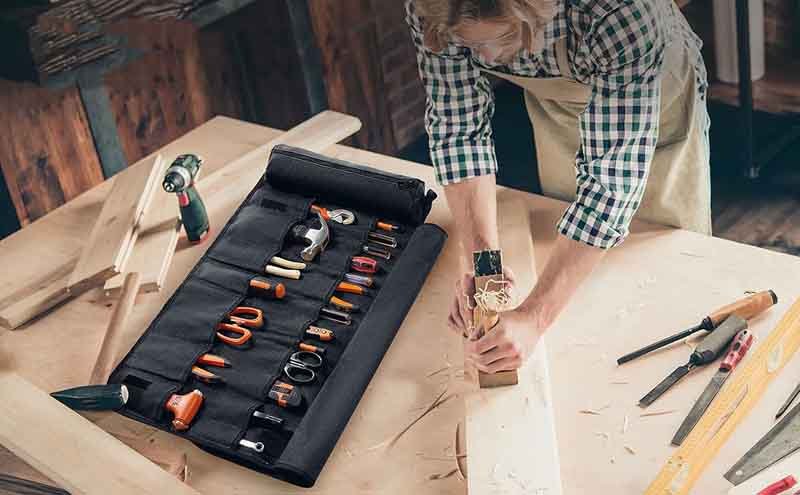
Choosing a roll-up tool bag depends on trade-specific toolsets, workspace environments, and portability needs. Key considerations include material (canvas vs. nylon vs. leather), size and pocket configuration to fit required tools, closure style (buckle vs. zipper), weight, and budget. Evaluate frequency of use, exposure to moisture or chemicals, and desire for custom branding. Match bag features to daily workflow for maximum efficiency.
Assessing Your Tool Inventory
Count and Categorize Tools:
- List essential tools (e.g., electricians: wire strippers, pliers, testers). Note dimensions (length, width) to ensure pockets aren’t too tight.
Account for Future Growth:
- If you plan to expand your toolset, choose a bag with extra pockets or modular attachment points.
Weight and Volume Calculation:
- Weigh each tool and sum weights. A roll-up bag should not exceed 10–12 lb when fully loaded to be comfortably carried by hand or over shoulder.
Pocket Size and Depth:
| Tool Type | Recommended Pocket Size (W x D in inches) | Notes |
|---|---|---|
| Pliers (7–8 in) | 3 x 6 | Pockets should be slightly taller than tool |
| Screwdrivers (5–7 in) | 1 x 5 | Narrow, shallow pockets |
| Hammers (12–14 in) | 6 x 12 (loop) | Loop anchored at bottom for stability |
| Voltage Tester | 2 x 6 | Fleece-lined to protect glass |
Material Considerations
Work Environment:
- Wet or oily conditions necessitate waterproof or oil-resistant fabrics like coated nylon or TPU-lined canvas.
- Budget-friendly garage use may allow basic untreated canvas.
Durability vs. Weight:
| Material | Durability Rating (1–5) | Weight (oz/sq yd) | Recommended Usage |
|---|---|---|---|
| Canvas (8–12 oz) | 3 | 8–12 | Light trades, hobbyists |
| Ballistic Nylon | 5 | 11–18 | Heavy trades, outdoor use |
| Leather (1.2 mm) | 5 | ~12 (varies) | Premium, specialty applications |
| Recycled Polyester | 4 | 6–8 | Eco-friendly, moderate trades |
Size and Configuration
Compact vs. Large Rolls:
- Choose a compact 12 x 18-inch roll if you carry fewer than 10 tools.
- Opt for 18 x 24-inch or larger if your toolkit exceeds 20 items or includes bulky equipment.
Pocket Layout Matching Your Workflow:
- Electricians need deep insulated pockets; carpenters need dedicated hammer loops and chisel slots.
- Check pocket orientation—vertical vs. horizontal pockets influence accessibility when bag is hung.
Closure Mechanism and Security
Buckles vs. Zippers vs. Velcro:
- Buckles: Very secure, adjustable tightness, durable over time.
- Zippers: Offer dust and moisture protection; potential failure if poor quality.
- Velcro: Quick release, noisy, loses adhesion with debris; not ideal for heavy-duty use.
Integrated Locking Options:
- Some premium models incorporate combination locks or RFID-blocking compartments—valuable for high-value tools like diagnostic electronics.
Branding and Customization
Private-Label vs. Off-the-Shelf:
- Off-the-shelf models ($20–$60) serve basic needs; limited color and tool-slot options.
- Private-label OEM/ODM ($50–$150+ per unit at MOQs of 200–500) allows custom pocket layouts, embroidered logos, and unique colorways.
Customization Methods:
- Embroidery and Debossing: Add logos or names; costs $5–$10 per bag plus die fees ($30–$100).
- Custom Pocket Layout: Specify exact pocket sizes and locations; additional prototyping cost $50–$150, then per-unit tooling premium $5–$10.
Budget and Value Assessment
Cost vs. Durability Trade-Off:
| Price Range (USD) | Typical Materials | Expected Lifespan (Heavy Use) |
|---|---|---|
| $20–$40 | Canvas, basic polyester | 6–12 months |
| $40–$80 | Ballistic nylon, reinforced | 1–2 years |
| $80–$150 | High-denier nylon, leather trim | 3–5 years |
| $150+ | Full-grain leather, custom features | 5–10 years |
Long-Term ROI:
- A $100 roll-up lasting 3–5 years may cost $20–$33 per year, versus a $30 bag needing replacement annually.
Trial and Custom Prototyping
- Sampling Programs:
- Many manufacturers offer sample prototyping ($50–$150 each) to test pocket configurations and fabric choices.
- Iterative Design:
- Test layout by placing tools in a temporary mock-up using paper templates taped to wall to simulate pocket placements before final production.
How Should You Maintain and Care for a Roll-Up Tool Bag?
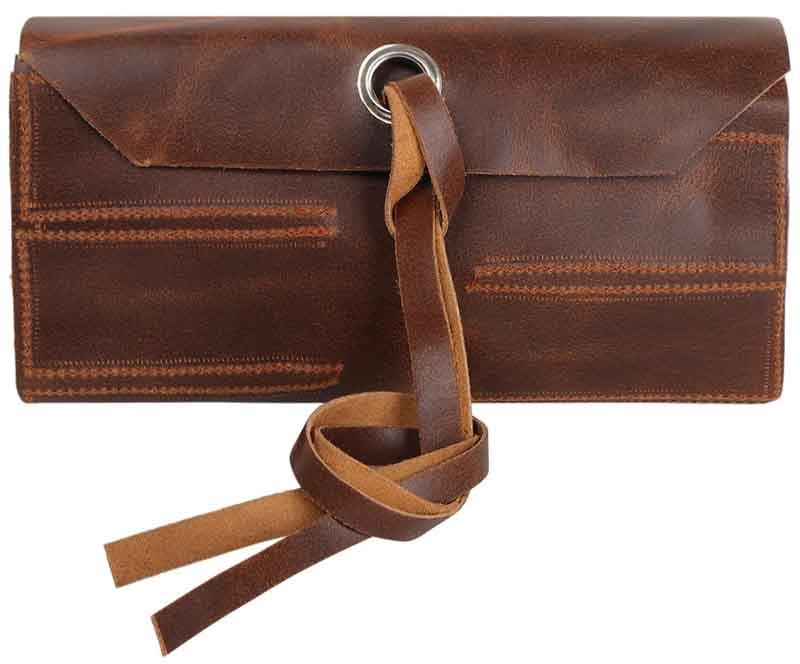
Keep your roll-up tool bag in top condition by emptying it and brushing out debris after each use, wiping down fabric surfaces with a damp cloth, and applying a protective spray (e.g., fabric water repellent) every 3–6 months. Leather sections benefit from a light conditioning with leather balm twice a year. Store the bag rolled loosely in a dry area to prevent mildew and strap deformation.
Regular Cleaning & Debris Removal
Empty and Inspect After Each Use:
- Remove all tools; shake out dirt, metal shavings, and debris.
- Use a soft-bristle brush to sweep out pocket interiors and seams.
Spot Cleaning:
- Canvas or nylon: Dampen cloth with mild soap solution (1 part detergent to 10 parts water), gently wipe stained areas, then rinse with clean water.
- Leather panels: Wipe with a slightly damp cloth, using specialized leather cleaner sparingly to avoid drying.
Deep Cleaning Schedule:
- Every 3 months: Fully unroll bag, wipe each pocket, use damp cloth on backing, and allow bag to air dry completely before rolling.
Protective Treatments
Fabric Water/Soil Repellent Sprays:
- Apply Scotchgard or similar fabric protector to canvas and nylon sections; costs $8–$15 per can.
- Provides water beading up to 5,000 mm water column; reapply every 3–6 months.
Leather Conditioners and Waterproofers:
- Use neatsfoot oil or beeswax-based balm on leather strips; prevents drying and cracking.
- Apply thin coat with lint-free cloth, let absorb 30 minutes, then buff with soft cloth.
Seam Sealants:
- For heavily used zippers and seams, apply Teflon-based seam sealer to reinforce waterproofness; adds $1–$2 in materials.
Repairing Wear and Tear
Patch Kits for Canvas/Nylon Tears:
- Use matching fabric patches and heavy-duty, weatherproof adhesive; ideal for small cuts under 2 inches.
- Cost of patch kit: $5–$10; covers multiple repairs.
Reinforcing Stressed Seams:
- Stitch back over worn seams with #69 bonded nylon thread.
- If pockets pull loose, reapply contact cement, press firmly, and hand stitch for permanent repair.
Zipper and Snap Replacement:
- Replace corroded or jammed zippers with YKK or SBS zippers—cost $2–$4 each; requires sewing machine or heavy-duty hand stitching.
- Snap or buckle wear often requires basic snap setter kit ($10–$20) to install new hardware.
Proper Storage Techniques
Avoid Mildew and Odors:
- Store bag unrolled or loosely rolled to allow airflow; never store damp.
- Use silica gel packs inside pockets to absorb moisture.
Prevent Strap Deformation:
- Hang bag on a hook at least once a month to relieve pressure from rolled shape.
- Avoid placing heavy objects on top of stored bags, which can crush pockets and distort shape.
Seasonal Checks and Renewal
Pre-Winter Inspection:
- Apply extra waterproofing and conditioners before heavy rains or snow to protect fabrics and leather.
Post-Season Refurbishment:
- Evaluate pocket stretch; retighten or replace pockets that have loosened.
- Check for color fading—consider re-dyeing leather accents or re-coating nylon with fabric spray for uniform appearance.
Long-Term Durability Metrics
| Maintenance Task | Frequency | Expected Benefit |
|---|---|---|
| Empty & Brush Debris | After every use | Prevents interior abrasion |
| Spot Cleaning | Monthly | Removes stains, prevents fabric breakdown |
| Fabric Repellent Reapplication | Every 3–6 months | Maintains water resistance |
| Leather Conditioning | Every 6 months | Preserves suppleness, prevents cracks |
| Hardware Check & Replacement | Annually or as needed | Ensures closures function reliably |
| Deep Inspection & Repair | Biannually | Extends bag lifespan by 1–2 years |
Cost of Ownership Analysis
Initial Bag Cost vs. Maintenance:
| Bag Type | Purchase Price (USD) | Annual Maintenance Cost (USD) | Expected Lifespan (Years) |
|---|---|---|---|
| Canvas Roll-Up | $20–$40 | $10–$15 | 1–2 |
| Nylon Roll-Up | $30–$60 | $15–$20 | 2–4 |
| Leather Roll-Up | $70–$150 | $20–$30 | 5–8 |
Total Cost Over Lifetime:
- A $50 nylon bag with $20 per year maintenance lasting 4 years costs $130 total—$32.50 per year.
- A $100 leather bag with $25 per year maintenance lasting 6 years costs $250 total—$41.67 per year, but offers higher durability and aesthetic longevity.
Conclusion
A roll-up tool bag is much more than a simple carrier—it’s a versatile, durable, and efficient way to organize, protect, and transport your tools. By selecting the right materials, design, and pocket configuration, professionals across trades—from electricians and plumbers to carpenters and mechanics—can streamline workflows, enhance tool longevity, and reduce downtime searching for the right instrument. Proper maintenance, including regular cleaning, protective treatments, and timely repairs, extends the bag’s lifespan, providing excellent long-term value.
Ready to create personalized roll-up tool bags that meet your exact specifications? Contact Szoneier for free design consultation, low-MOQ prototyping, and premium OEM/ODM manufacturing.



